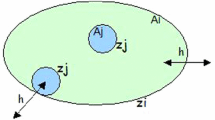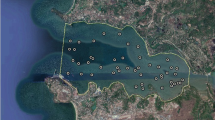Abstract
Marine research survey data on fish stocks often show a small proportion of very high-density values, as for many environmental data. This makes the estimation of second-order statistics, such as the variance and the variogram, non-robust. The high fish density values are generated by fish aggregative behaviour, which may vary greatly at small scale in time and space. The high values are thus imprecisely known, both in their spatial occurrence and order of magnitude. To map such data, three indicator-based geostatistical methods were considered, the top-cut model, min–max autocorrelation factors (MAF) of indicators, and multiple indicator kriging. In the top-cut and MAF approaches, the variable is decomposed into components and the most continuous ones (those corresponding to the low and medium values) are used to guide the mapping. The methods are proposed as alternatives to ordinary kriging when the variogram is difficult to estimate. The methods are detailed and applied on a spatial data set of anchovy densities derived from a typical fish stock acoustic survey performed in the Bay of Biscay, which show a few high-density values distributed in small spatial patches and also as solitary events. The model performances are analyzed by cross-validating the data and comparing the kriged maps. Results are compared to ordinary kriging as a base case. The top-cut model had the best cross-validation performance. The indicator-based models allowed mapping high-value areas with small spatial extent, in contrast to ordinary kriging. Practical guidelines for implementing the indicator-based methods are provided.













Similar content being viewed by others
References
Bez N, Braham C (2014) Indicator variables for a robust estimation of an acoustic index of abundance. Can J Fish Aquat Sci 71:709–718
Doray M, Masse J, Petitgas P (2010) Pelagic fish stock assessment by acoustic methods at Ifremer. http://archimer.ifremer.fr/doc/00003/11446/
Fréon P, Misund O (1999) Dynamics of pelagic fish distribution and behaviour: effects on fisheries and stock assessment. Blackwell Science, Oxford
Fujiwara M (2008) Identifying interactions among salmon populations from observed dynamics. Ecology 89:4–11
Goulard M, Voltz M (1992) Linear coregionalization model: tools for estimation and choice of cross-variogram matrix. Mathe Geol 24:269–286
Guiblin P, Rivoirard J, Simmonds E (1995) Analyse structurale de données à distribution dissymétrique : exemple du hareng écossais. Cah Géostat 5:137–160
Matheron G (1974) Effet proportionnel et lognormalité ou : le retour du serpent de mer. Note N-374, Centre de Géostatistique de Fontainebleau. http://cg.ensmp.fr/bibliotheque/
Matheron M (1981) La sélectivité des distributions. N-686, Centre de Géostatistique de Fontainebleau. http://cg.ensmp.fr/bibliotheque/
Matheron G (1982) La déstructuration des hautes teneurs et le krigeage des indicatrices. Note N-761, Centre de Géostatistique de Fontainebleau. http://cg.ensmp.fr/bibliotheque/
Matheron G (1988) Geostatistics. In: Armstrong M (ed) Two classes of isofactorial models. Kluwer Academic Publishers, Dordrecht, pp 309–322
R Core Team (2016) R: a language and environment for statistical computing. R foundation for statistical computing. R Core Team, Vienna, Austria. https://www.R-project.org/
Renard D, Bez N, Desassis N, Beucher H, Ors F, Laporte F (2014) RGeostats: the geostatistical package [version 11.0.2]. MINES ParisTech. http://cg.ensmp.fr/rgeostats
Rivoirard J (1990) A review of Lognormal estimators for in-situ reserves. Math Geol 22:213–221
Rivoirard J (1994) Introduction to disjunctive kriging and non-linear geostatistics. Clarendon Press, Oxford
Rivoirard J, Demange C, Freulon X, Lécureuil A, Bellot N (2013) A top-cut model for deposits with heavy-tailed grade distribution. Math Geosci 45:967–982
Rivoirard J, Freulon X, Demange C, Lecureuil A (2014) Kriging, indicators and non-linear geostatistics. J South Afr Inst Min Metall 114:1–6
Switzer P, Green A (1984) Min/Max autocorrelation factors for multivariate spatial imagery. Technical Report No. 6, Department of Statistics, Stanford University
Woillez M, Rivoirard J, Petitgas P (2009) Using min/max autocorrelation factors of survey-based indicators to follow the evolution of fish stocks in time. Aquat Living Resour 22:193–200
Woillez M, Walline P, Ianelli J, Dorn M, Wilson C, Punt A (2016) Evaluating total uncertainty for biomass- and abundance-at-age estimates from eastern Bering Sea walleye pollock acoustic-trawl surveys. ICES J Mar Sci 73:2208–2226
Acknowledgements
We are grateful to the crew of the research vessel Thalassa and to E. Duhamel, F. Sanchez and P. Grellier from Ifremer for preparing the biological and acoustic data. We would also like to thank the referees, whose comments allowed us to improve the manuscript. D. Renard (Mines Paris Tech) helped to improve the English. The work was partly funded by the European Union H2020 project CERES. The data were collected by Ifremer within the French national observation plan, a part of the EU fisheries data collection framework.
Author information
Authors and Affiliations
Corresponding author
Rights and permissions
About this article
Cite this article
Petitgas, P., Woillez, M., Doray, M. et al. Indicator-Based Geostatistical Models For Mapping Fish Survey Data. Math Geosci 50, 187–208 (2018). https://doi.org/10.1007/s11004-018-9725-2
Received:
Accepted:
Published:
Issue Date:
DOI: https://doi.org/10.1007/s11004-018-9725-2




